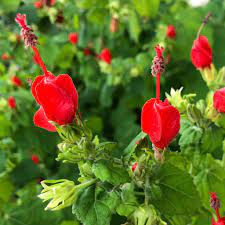by Belinda C. Morin,
Aransas-San Patricio Master Gardener
Here in south Texas, we have the dual challenge of finding plants that will do well in the shade, but also withstand staggering temperatures and drought conditions in late summer. Turk’s Cap/Mexican Apple (Malvaviscus arboreus) is a great Texas tough native that thrives in these conditions and is great for beginners because it is versatile and easy grow.
Turk’s Cap is a low growing perennial shrub that spreads easily with leaves that look like baseball mitts. It is native to the high elevation cloud forests of Mexico and Colombia, and can be found in subtropical Texas and Florida and other southeastern states. Turk’s cap flowers got their common name because of their twisted bright red up-right hibiscus-like blooms that look like a Turkish turban. Blooms eventually turn into tiny, red apple-like fruits that are a favorite of birds and wildlife.
What is the correct name for Turks Cap? The scientific name of the Turk’s Cap I’m referring to is Malvaviscus arboreus var. drummondii. But just a heads up, there is another plant called Turk’s Cap that is Malvaviscus penduliflorus. It is native to Mexico and looks like Malvavisus arboreus except the flowers hang down versus upright. According to wildflower.org (Lady Bird Johnson Wildflower Center website), other common names for Turk’s Cap include Wax Mallow, Mexican Apple, Sleeping Hibiscus, Bleeding Hearts, and Manzanita. Another completely different plant also goes by the common name Turk’s Cap, however this plant is a lily (Lilium superbum). Mind spinning yet? Common names can cause confusion; therefore, it is always a good idea to know the scientific name of a plant to avoid confusion at the nursery or when ordering seeds.
There are lots of reasons to grow Turk’s Cap in your garden. For one, the beautiful red flowers reliably bloom for 6 months out of the year. From May to November, you can expect this beauty to shine in full sun or shade. When most flowering plants are struggling in the heat of the summer or the drought of winter, steadfast Turk’s Cap is there adding a pop of color to the wet or dry; sandy, clay, alkaline or acidic soils of your flower bed.
Turk’s Cap has a sweet honeysuckle taste, is a favorite of pollinators and hummingbirds, a food source for wildlife, and serves as the primary host plant for the caterpillars of the Turk’s-cap White Skipper (Helipetes macaira). Other birds and wildlife adore the red fruit this well-rounded plant provides. We need more butterfly and moth host plants in our yards. Why? because without caterpillars we might not have birds. According to butterfliesandmoths.org, female butterflies and moths lay their eggs on the twigs and buds of the host plant, and baby caterpillars feed on the plant’s leaves, flowers and fruit.
Turk’s Cap Plant Care Tips
An established plant does not need to be watered very often; depending on rain fall amounts, watering every 5 or 6 days should suffice with less watering the rest of the year. Plants typically die back in the winter once the cold temperatures hit. Cut back to 4 or 5 inches above ground during winter – or leave the dead foliage alone on this and other plants because they provide shelter for certain birds and other little garden beneficial creatures.
Edibility and Medicinal Purposes
In Mexico the flowers are used to treat digestive inflammation and as a menstrual cycle aid. The flowers, either fresh or dried, can be used to make tea. Turk’s Cap leaves look and taste like baby spinach and can be steamed, sauteed, boiled or stir fried. The fruit, when ripe, is a favorite of Texas foragers because it tastes like apples without the tartness and can be made into jelly, jam or wine. Seeds can also be eaten raw but have a nutty flavor if lightly toasted over a campfire
.
Directions for canning Turks Cap/Manzanita Jelly:
Cover two cups Turk’s cap fruit with water, bring to a boil. Reduce heat and simmer for 20 minutes or until softened. Mash the fruit and strain through cheesecloth or a jelly bag. Bring the liquid back to a boil, add 2 tablespoons pectin and bring to a rolling boil that will not stop when stirred. Add 1/2 cup of sugar and boil about a minute or two more. Pour contents into sterile jars and process using water bath method.
This versatile, easy to grow, and highly beneficial plant is my favorite, and I am sure it will be yours too!
Master Gardeners is a non-profit program of Texas A&M Agrilife Extension Service. Be sure to visit our Coast Oaks Demonstration Garden: 892 Airport Rd., Rockport. Contact us: MG Helpline: 361-790-0103 ♦ Email: [email protected] ♦ Website: http://aspmastergardeners.org/ ♦ Facebook: facebook.com/aspmastergardeners ♦ Online Plant Store: https://aspmgstore.org/

